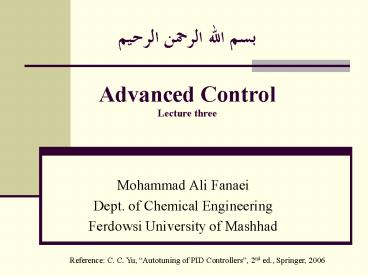??? ???? ?????? ?????? Advanced Control Lecture three - PowerPoint PPT Presentation
Title:
??? ???? ?????? ?????? Advanced Control Lecture three
Description:
Advanced Control Lecture three Mohammad Ali Fanaei Dept. of Chemical Engineering Ferdowsi University of Mashhad – PowerPoint PPT presentation
Number of Views:61
Avg rating:3.0/5.0
Title: ??? ???? ?????? ?????? Advanced Control Lecture three
1
??? ???? ?????? ??????Advanced ControlLecture
three
- Mohammad Ali Fanaei
- Dept. of Chemical Engineering
- Ferdowsi University of Mashhad
Reference C. C. Yu, Autotuning of PID
Controllers, 2nd ed., Springer, 2006
2
Off-Line Tuning of PID Controllers
About 250 tuning rules are exist for PI and PID
Controllers What is the suitable tuning rule?
It really depends on your process (Type, Order,
Parameters, Nonlinearity, Uncertainty, etc)
- Ziegler-Nichols(1942) Recommended for 0.2lt D/t
lt2 ( )
3
Off-Line Tuning of PID Controllers
- Tyreus-Luyben(1992) Recommended for
time-constant dominant processes
- Ciancone-Marlin(1992) Recommended for dead-time
dominant processes
4
Off-Line Tuning of PID Controllers
- PID tuning based on IMC (Rivera et al., 1986)
5
On-Line Tuning of PID Controllers
- Ziegler-Nichols Test (1942)
- Set the controller gain Kc at a low value,
perhaps 0.2. - Put the controller in the automatic mode.
- Make a small change in the set point or load
variable and observe the response. If the gain
is low, then the response will be sluggish. - Increase the gain by a factor of two and make
another set point or load change. - Repeat step 4 until the loop becomes oscillatory
and continuous cycling is observed. The gain at
which this occurs is the ultimate gain Ku , and
the period of oscillation is the ultimate period
Pu.
6
On-Line Tuning of PID Controllers
- Relay Feedback Test (Astrom Hagglund, 1984)
7
On-Line Tuning of PID Controllers
- Relay Feedback Test
- Bring the system to steady state.
- Make a small (e.g. 5) increase in the
manipulated input. The magnitude of change
depends on the process sensitivities and
allowable deviations in the controlled output.
Typical values are between 3 and 10.
- As soon as the output crosses the SP, the
manipulated input is switched to the opposite
position (e.g. 5 change from the original
value). - Repeat step 2 until sustained oscillation is
observed . - Read off ultimate period Pu from the cycling and
compute Ku from the following Equation Ku
4h/(pa)
8
On-Line Tuning of PID Controllers
- Advantages of Relay Feedback Test
- It identifies process information around the
important frequency, the ultimate frequency. - It is a closed-loop test therefore, the process
will not drift away from the nominal operating
point. - The amplitude of oscillation is under control (by
adjusting h ). - For processes with a long time constant, it is a
more time-efficient method than conventional step
or pulse testing. The experimental time is
roughly equal to two to four times the ultimate
period. - If the normalized dead time D /t is less than
0.28, the ultimate period is smaller than the
process time constant. Therefore the relay
feedback test is more time efficient than the
step test.
9
On-Line Tuning of PID Controllers
- Advantages of Relay Feedback Test
10
On-Line Tuning of PID Controllers
- Process model identification from a
- Relay Feedback Test
11
Recommended Tuning Formulas
The following formulas are recommended by Luyben
and Yu for tuning The PI controllers
12
Example 3 Using relay Feedback
In this example for the system that described in
example 2 a relay feedback test is used for
on-line tuning of a PI controller






























